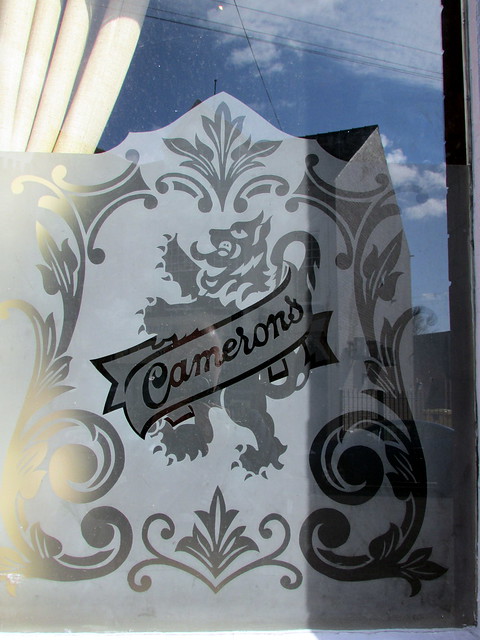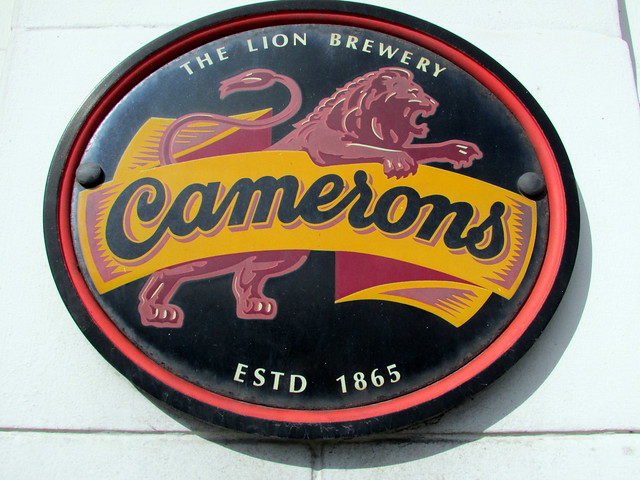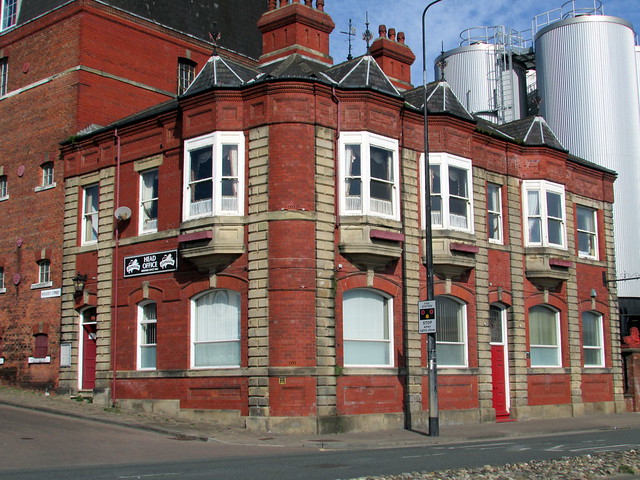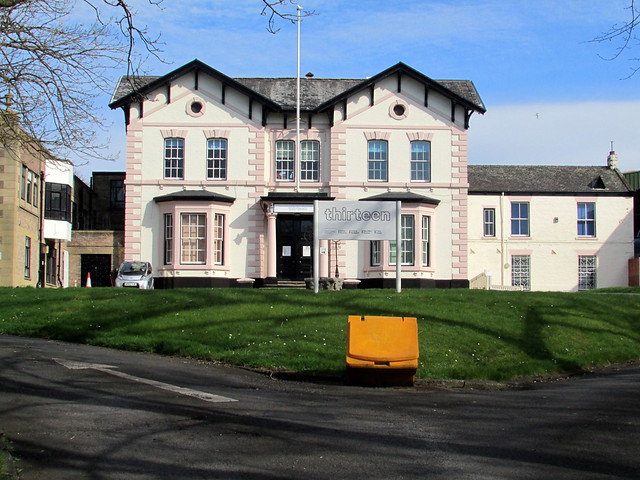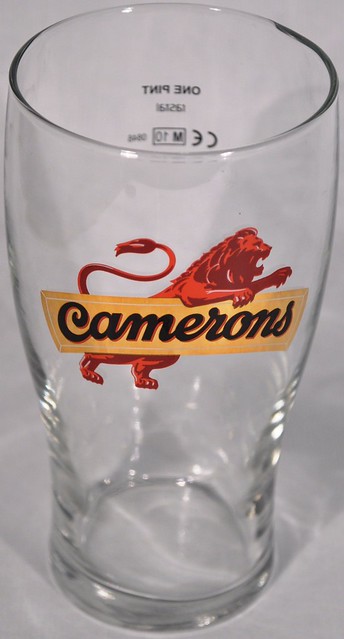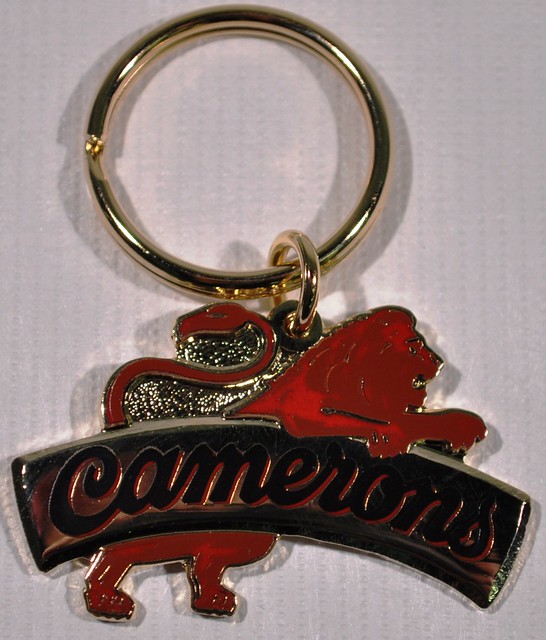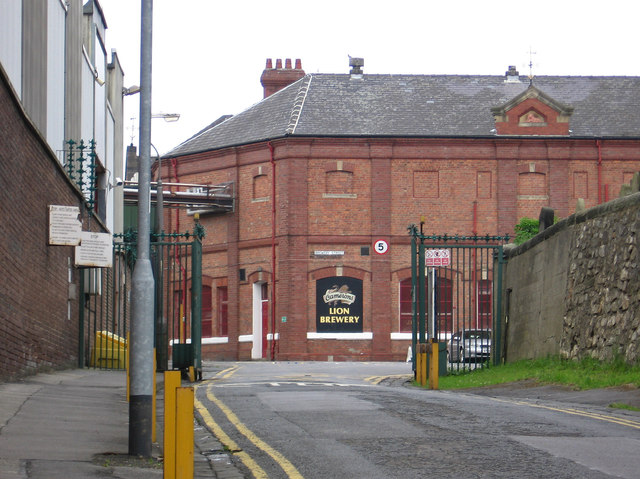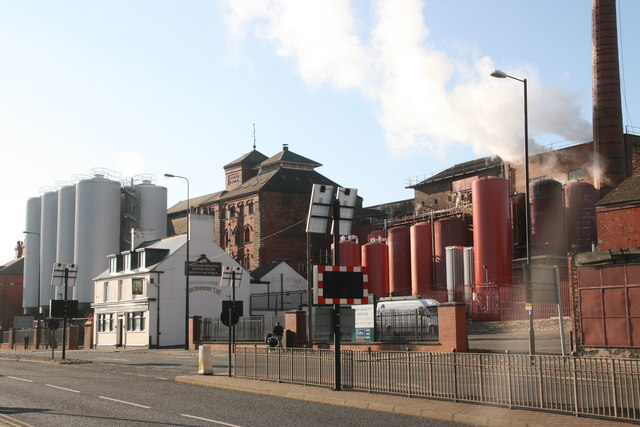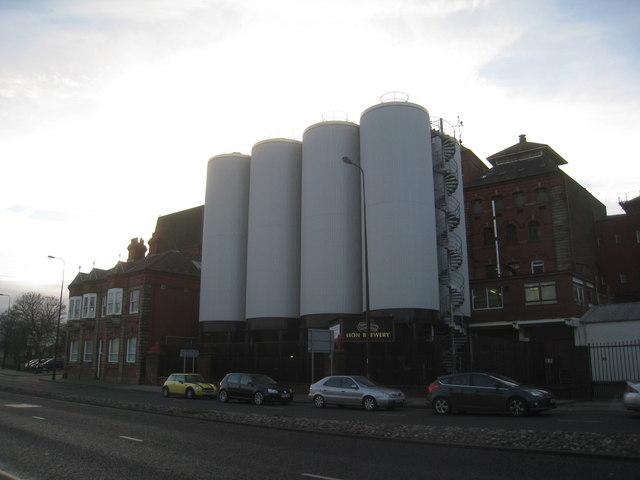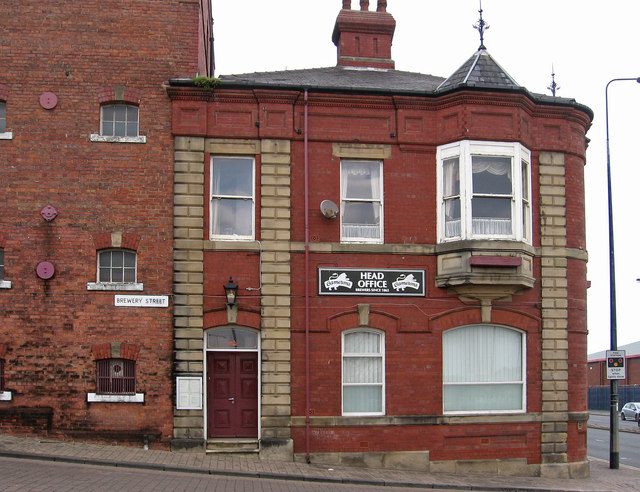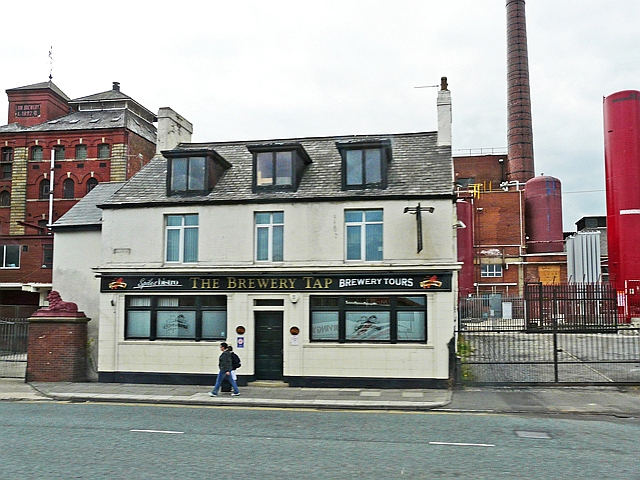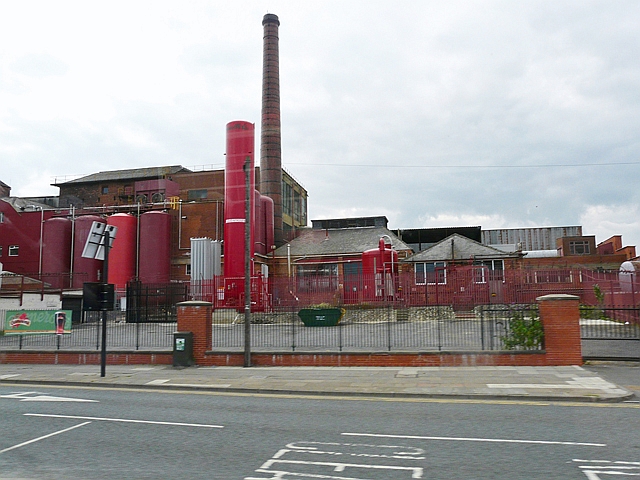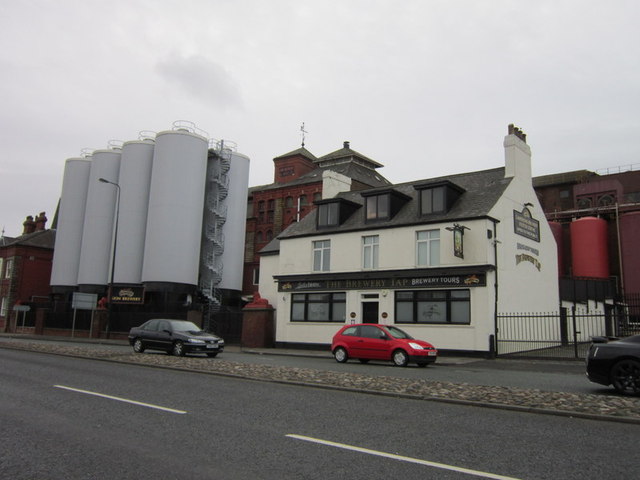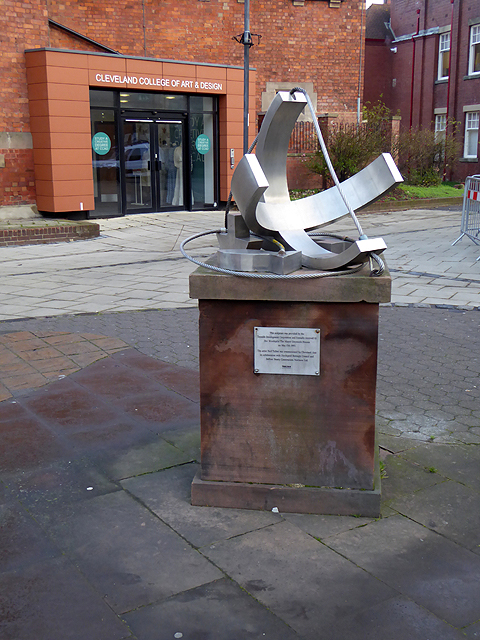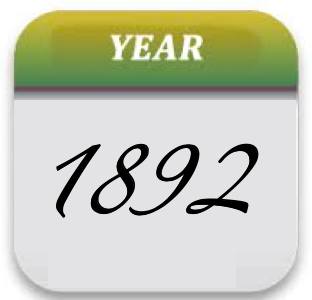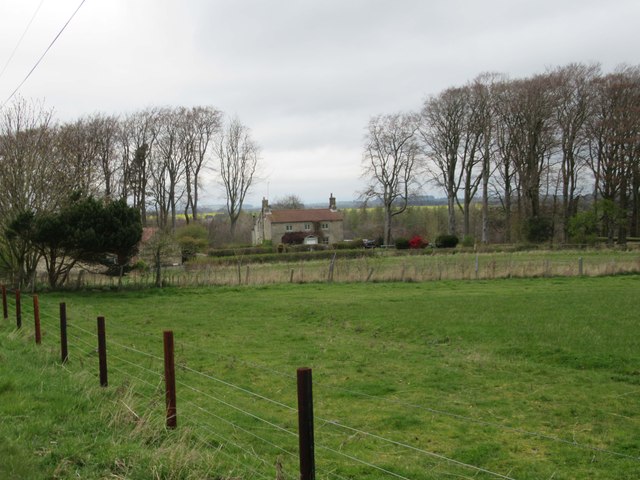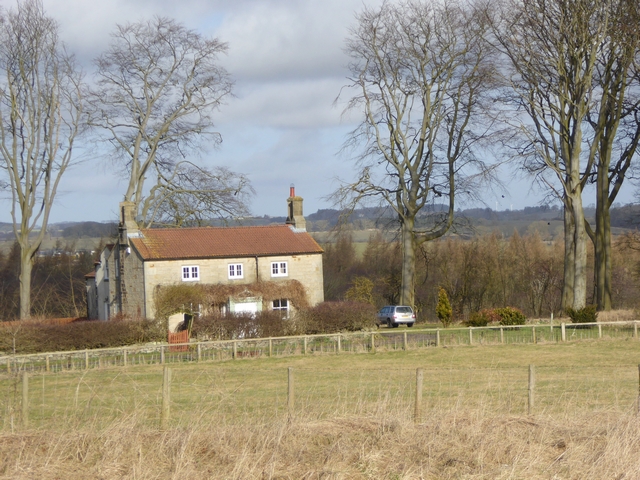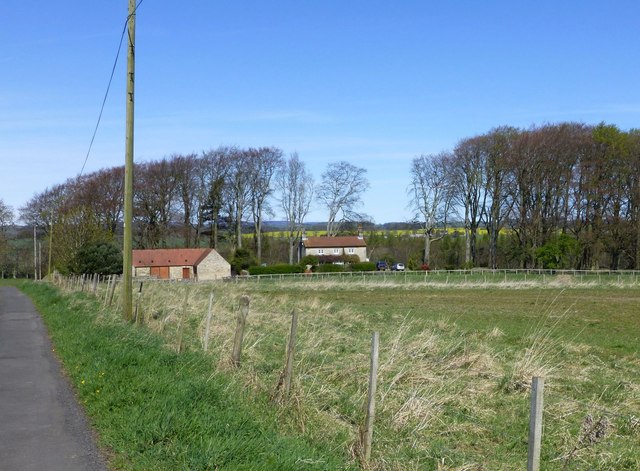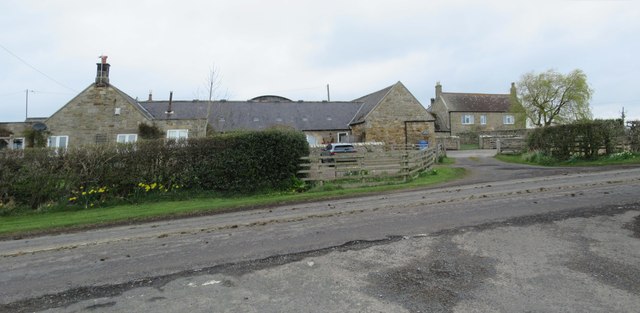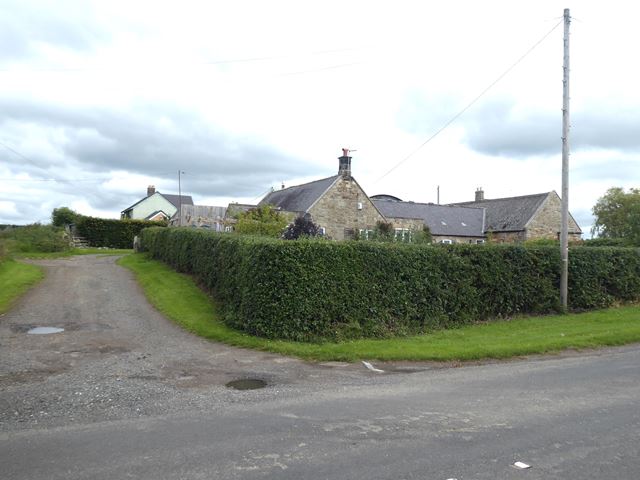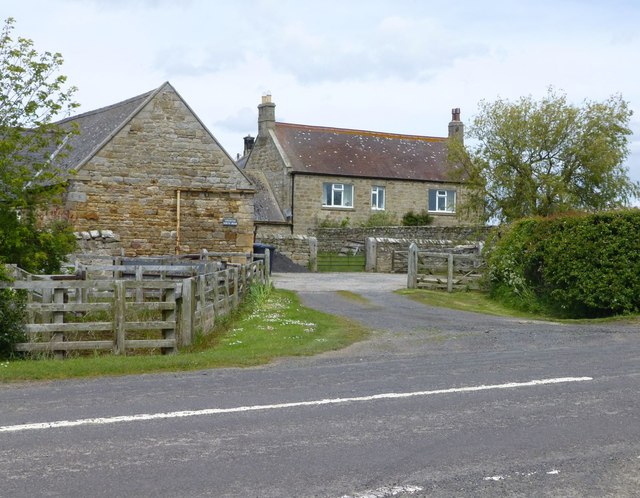Topics > Tees Valley > Hartlepool > Camerons Brewery
Camerons Brewery
Camerons Brewery Ltd was founded in 1865 by John William Cameron in Hartlepool. The main brewery building is called the Lion Brewery, built in 1892. The site has two wells, one of them 250 feet deep, and brewing on the site can be traced back to the 16th century. The brewery has a visitor centre and a Website with a history section.
Camerons Brewery Ltd is a brewery founded in 1865 by John William Cameron in Hartlepool, County Durham, England. It is the largest independent brewer in the North East of England, with a brewery capacity of 1.5 million hectolitres (900,000 hl production in 2012) and a tied estate of 75 houses. It is one of the town's oldest industrial concerns, and has historically been one of the largest employers.
After one hundred years of growth through brewery acquisitions, the company had an estate of 750 licensed premises throughout the North East and North Yorkshire by the 1960s. The company subsequently struggled as the economy of its trading heartland suffered, and as it underwent a succession of owners with little experience of running pubs and breweries. Camerons lost its independence to Ellerman Lines in 1974, followed by the Barclay Brothers in 1983 and Brent Walker in 1989. Brent Walker spun off the majority of the tied estate as a separate company called Pubmaster, which was acquired by Punch Taverns in 2003.
Camerons was purchased in 1992 by Wolverhampton & Dudley, which invested heavily in the brewery before selling the company to Castle Eden in 2002, who closed their own site and moved all production to Camerons. The company now has a relatively small tied estate but the ninth largest brewery in the country. As a result, around 80 per cent of its business involves contract brewing for other companies, such as Heineken, which owns 24 per cent of the company, and Carlsberg.
Camerons is known across the United Kingdom for Strongarm, a distinctive ruby red bitter launched in 1955. Total production of Strongarm surpassed one billion pints in 2000. Across the North East it is also known for Castle Eden Ale and Trophy Special, both originally brewed at Castle Eden.
History
Early history
A 250-foot artesian well has been used for brewing on the site since at least 1572. William Waldon (1805 - 1854), a farmer originally from Gainford, founded the Lion Brewery in the village of Stranton (subsequently a part of West Hartlepool) on land he bought from Ralph Walker for £300 in 1852. After Waldon's death in 1854, the brewery passed to his widow, Jane. John William Cameron was enlisted to run the brewery from 1865. In 1872 he took on the brewery and its 16 public houses under a 21-year lease. Henry Wilson, of the Phoenix Works in Stockton-on-Tees, built new brewery facilities for John Cameron in 1875. Further land for expansion of the brewery was purchased in 1876. Between 1885 and 1890 more land was bought and plans were made to build a new brewery. The present brewery building was completed in 1892. When the lease expired in 1893, Cameron purchased the brewery outright from the Waldons for £34,442.
Public listing and acquisition trail
In 1894 the company went public, valued at £345,000, and owned 119 public houses. John William Cameron used this juncture to enter into semi-retirement, and managerial responsibility was devolved to his brother, Watson Cameron (died 1920).
Nixey, Coleclough & Baxter of the Brunswick Brewery in Hartlepool, was acquired in 1895, along with around 80 public houses. It had been the largest competing brewery in Hartlepool. The newly acquired brewery was closed in 1898, and Nixey and Baxter were both appointed to the Camerons board.
John William Cameron died in 1896, by which time the brewery was one of the largest in the North of England.
In 1897, T E Chapman & Son of Sunderland was acquired with 83 public houses, and its managing director, Abel Chapman, joined the Cameron board of directors. By this time, John Ellerman was vice chairman of Camerons.
That same year, the Lion Brewery was further extended, to a 70 quarter capacity, capable of producing 130,000 barrels a year. In 1899 Camerons began to bottle mineral water and the company continued to expand. By this time 400 licensed premises were owned, including the majority of Hartlepool's public houses. The company prospered, and by 1907 the share capital of the company was £350,000 with another £350,000 of capital in the form of mortgage debenture stock.
In 1910, Heslop's Grange Brewery in Stockton was acquired along with 28 licensed houses. John Ellerman was company chairman by 1913. In 1915 the Lion Brewery was damaged by German shellfire. In 1920 Watson Cameron died, and A. J. Morgan and H. J. Hewlett became joint managing directors of the company. Morgan was in charge of organization and the offices, whilst Hewlett was in charge of brewing. Robert Newton Ltd of Newcastle was acquired, with 35 licences, and Plews and Sons Ltd of Darlington, with 100 licensed premises. In 1922, Watson's son, John Watson Cameron joined the company, and in 1935 he was made chairman and managing director.
Cameron's ale was sold as far north as Newbiggin-by-the-Sea in Northumberland, as far east as Guisborough, as far west as Hawes and as far south as Thirsk by 1938. Over 400 licensed houses were owned. Directly and indirectly the company employed 1,500 people. Cameron's owned 46 per cent of all public houses within the Borough of Hartlepool by 1939.
In 1950, John Watson Cameron's wife, Lillian, was appointed to the board, responsible for the furnishings and decoration of Cameron's licensed houses. In 1953, the Stranton bottling facility was opened. In March 1955, Strongarm bitter was introduced, as the industrial workers of West Hartlepool demanded a stronger pint.
In 1953, a controlling interest was acquired in John J Hunt, which owned the Ebor Brewery in York and Scarborough & Whitby Breweries along with 200 licensed public houses. In 1956 J Fryer & Sons of Brompton-on-Swale was acquired. In 1959 the West Auckland Brewery was acquired with 80 licensed public houses. In 1961 Russell & Wrangham of Malton was acquired with 90 licensed public houses. By 1967 the company had a market capitalization of £6.7 million, or £106 million in 2013 prices. In 1971, John Watson Cameron retired as managing director, although he remained as executive chairman, and his son, John Martin Cameron, became managing director. Camerons introduced its own "lager" brand, Icegold, in 1972. Icegold was top fermented and actually a very pale ale rather than an authentic lager.
Corporate ownership
In January 1974, Ellerman Lines acquired the 25 per cent stake in Camerons previously owned by Sir John Ellerman, 2nd Baronet, who had died. Directors and Cameron family members held a 9 per cent stake and Bass Charrington held 10 per cent.
In 1975, the company was acquired by Ellerman Lines for £14 million, in an attempt to diversify from its declining shipping business. By this time Cameron's owned 500 pubs and 100 off-licences.
In 1980 Hansa lager was launched, brewed under licence from Dortmunder Actien Brauerei. Camerons spent £2 million to upgrade their brewing facilities in order to brew bottom fermented lager, in what CAMRA described as "the most ambitious scheme for a regional brewer yet". The company had sales of £51 million in 1981, and one per cent of the British beer market. Market share in the Tees Valley area was 25 per cent.
In 1983, Ellerman Lines was acquired by the Barclay brothers for £45 million. In 1984, the Barclays attempted to sell Camerons to Scottish & Newcastle for £44 million, but the brothers cancelled the negotiations when the government referred the deal to the Monopolies Commission.
In 1985, Cameron's held five per cent of the UK beer market. In 1985, the maltings building was demolished. Alistair Arkley was appointed managing director in 1985. Arkley split the pub and the brewing sides of the company into separate divisions, and divested the low-margin off-licence business. In 1986, Cameron's acquired 90 pubs from Mansfield Brewery, including 78 northern pubs and clubs, most of which were former North Country Breweries outlets, for £13 million. In 1988, the company expanded into the North West for the first time after it acquired 17 pubs in north Lancashire.
In 1988, Camerons and Tolly Cobbold were sold to Brent Walker for £248 million. Camerons controlled 480 licensed public houses and 270 hotels and off-licences. In 1989, Camerons Brewery was described as one of the most efficient in the country, with a total annual capacity of over 500,000 barrels and production of 400,000.
In 1991, the heavily-indebted Brent Walker sold the brewery and 51 pubs to Wolverhampton & Dudley for £18.7 million, beating a rival offer from the management. Brent Walker retained the bulk of the Cameron's estate, which it spun off as a Hartlepool-headquartered pubco called Pubmaster, which controlled 1,600 pubs and was sold to a syndicate of investment groups for £171.3 million in 1996. Meanwhile, the soft drinks arm was spun off under a management buyout called Orchid Drinks, with brands including Purdey's and Amé (acquired by Britvic in 2000 for £67 million).
W&D had acquired a company that was in a "sorry state". Initially, brewery staff numbers were reduced from 360 to 120, and part of the brewery was mothballed, after W&D ended a contract to brew Labatt lager at the plant. However, W&D invested heavily in the brewery site and marketing, and the profitability of the brewery greatly improved. By 1995 W&D had doubled the size of the Cameron pub estate they inherited to 101 pubs. It was widely suggested by customers that the Camerons beers greatly improved after being acquired by W&D.
In 1997, contract brewing returned to the plant, with a licence to brew Foster's lager. By 1997, Cameron's market share in the North East had grown to 10 per cent, supplying pubs from Alnwick to Hull. In 1998, £1 million was spent on a new filtration and fermentation system and a keg plant at the brewery. In 1999, a further £500,000 was invested in the previously mothballed areas of the brewery to bring it to its full capacity of 400,000 barrels after it won a series of contracts to brew Harp Lager, Heineken and Kronenbourg.
Total production of Strongarm surpassed one billion pints in 2000. The 2002 Good Beer Guide remarked that the Strongarm was "Now substantially improved and with consistent character".
Independence
Castle Eden Brewery, owned by David Soley, took over Camerons in April 2002 for £35 million, moving all operations to Hartlepool and closing down the Castle Eden plant. The Kronenbourg 1664 contract was renewed by Scottish & Newcastle in December 2002. In 2003, £500,000 was spent to build a new bottling line and an on-site microbrewery, The Lion's Den. In 2008, Cameron's spent £4 million expanding its capacity from 375,000 barrels to around 800,000 barrels. This followed the agreement of a contract with Scottish & Newcastle to supply Kronenbourg 1664, Foster's and John Smith's bitter until 2019. Previously the brewery had only produced Kronenbourg 1664.
In 2013, Camerons acquired the Hexham-based Head of Steam craft beer chain, including seven outlets, in a deal financially backed by Carlsberg.
In 2015, Gold Bullion joined Strongarm as a year-round beer.
In July 2016, Camerons acquired Leeds Brewery's estate of seven pubs.
Operations
In 2011, the brewery had a capacity of over 1.5 million hectolitres (over 1 million barrels) per annum. Production in 2012 was 900,000 hectolitres, with around 40,000 hl in own brand sales. The bulk of the brewery's own production is cask conditioned ale but it also sells bottled and keg ales. The company's most famous beer is Strongarm, a 4% abv bitter introduced in 1955, and other regular beers are IPA, Bullion Gold and Trophy Special. Strongarm is made with 18 per cent crystal malt, which contributes significantly to its distinctive ruby red colour and its roasted, malty flavour.
The barley comes from Yorkshire and Scotland. Camerons uses up to five different yeast strains for its various brands.
Its arrangements with brewing companies include contracts to produce Foster's, Kronenbourg 1664, John Smith's Magnet, Tetley Imperial, and the keg versions of Tetley Mild and Tetley Dark Mild.
The company owns 75 public houses.
Heineken holds a 24 percent stake in the company. However it is a silent partner, with no board representation or managerial control.
The Lion Brewery
The brewery building is called the Lion Brewery, and the company offers tours of the brewery. Camerons Brewery in Hartlepool has two wells, one of them 250 feet deep. Most of the brewery was built in 1890 when the company had aspirations to supply the whole of the North East. There are still a few reminders of lavish opulence; the floor and walls of the brewhouse are furnished with Italian marble that cost £7,000 in 1970.
In 2011, the brewery had a capacity of over 1.5 million hectolitres per annum. It is the ninth largest brewery in the UK. It has twelve Yorkshire Squares for brewing ale.
In 2013, the brewery building was used as a filming location in the "Prodigal Son" episode of Vera.
A £700,000 visitor's centre was opened next to the brewery in 2004, in the former Stranton Arms public house.
Advertising and sponsorship
In 1996, a £500,000 television and radio campaign saw Cameron's Strongarm advertised across Yorkshire and the Midlands for the first time.
Cameron's was one of the first breweries to sponsor football kits, with Middlesbrough FC from 1984–86 and Hartlepool United from 1985-1990 and 1993-2000.
In 2014, Cameron's began sponsoring BriSCA F1 driver John Downson Jnr, from Thornley. Dowsy, as he is often referred to, is a North East stockcar racer who races under the number 94. John has previously raced BriSCA F2s, where he was the 2012 pole sitter in the BriSCA Formula 2 Stock Cars World Championship race at Barford Raceway, before making the switch to the more powerful V8 powered formula, the BriSCA F1s later in the year. John is the first driver from the area to feature in a BriSCA Formula 1 Stock Cars World Championship title race for almost 20 years, finishing 10th in 2013, narrowly avoiding qualifying for the event in 2014.
Visit the page: Camerons Brewery for references and further details. You can contribute to this article on Wikipedia.
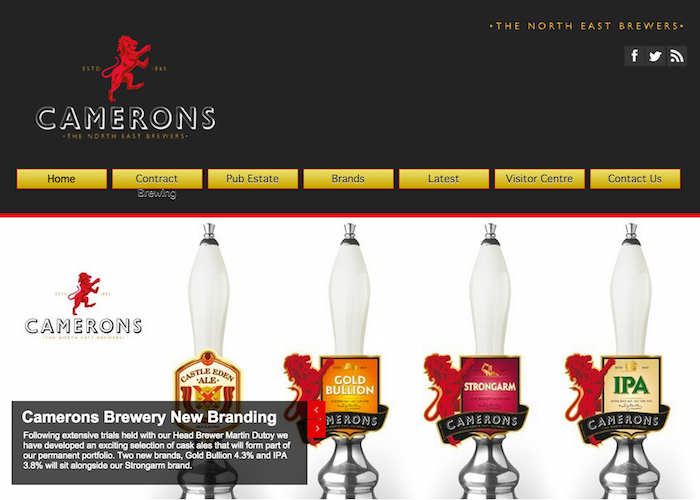
from http://www.cameronsbrewery.co…
Camerons - the North East Brewers
- "...Camerons Brewery Visitor Centre is on the site of the former Stranton pub. It offers a remarkable and educational insight into beer production but is also fascinating story of entrepreneurial …
Added by
Simon Cotterill
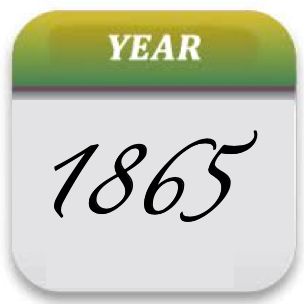
Co-Curate Page
1865
- < 1864 | 1865 | 1866 > In Northern England: 1865; Camerons Brewery Ltd was founded by John William Cameron in Hartlepool.


from http://www.cameronsbrewery.co…
Camerons - the North East Brewers
- "...Camerons Brewery Visitor Centre is on the site of the former Stranton pub. It offers a remarkable and educational insight into beer production but is also fascinating story of entrepreneurial …
Added by
Simon Cotterill


